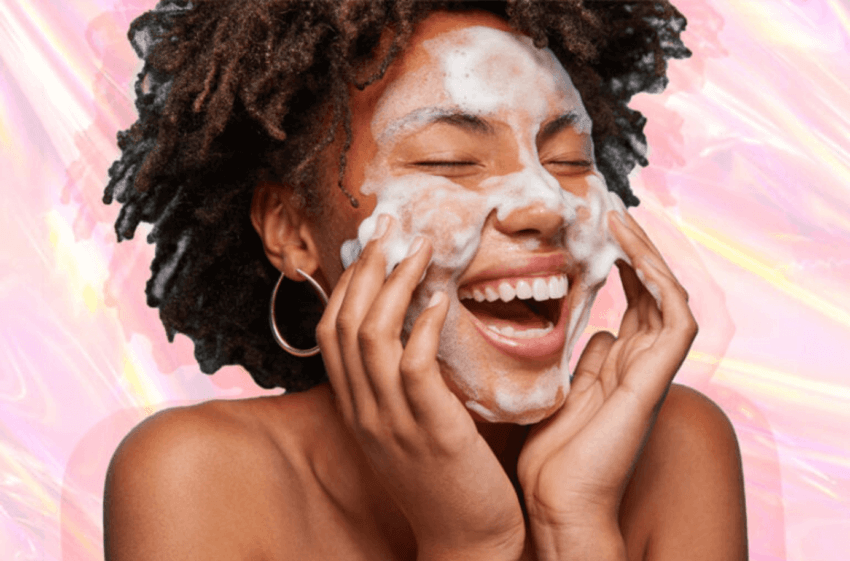Derms Say These are the Biggest Acne Misconceptions

We’ll give it to you straight: there’s still a lot to uncover regarding the medical world’s greater understanding of acne. What we do know is that there’s a correlation between oil production and/or hormones and acne, and that treatments need to be highly customized and often come with some trial and error. We also know that misconceptions about acne are rampant, so today we’re taking a sec to break down the most common myths out there.
The Myth: Acne is a Sign of Poor Hygiene
 via Giphy
via Giphy
The ironic part about this myth is that people with acneic skin often have aggressive skincare regimens in their attempt to improve skin clarity. In other words, they might have a more detailed regimen than those with effortlessly flawless complexions!
“Acne is not the result of poor hygiene,” says Dr. Eric Rudnick, a board-certified dermatologist and founder of Dazzling Dermatology in Boca Raton, Fla. “In fact, patients can practice perfect facial and skin hygiene and still develop both acne vulgaris and fungal ‘acne.’”
The Myth: Acne-Prone Skins Should Have an Aggressive Skincare Routine
 via Giphy
via Giphy
For mild to moderate cases of acne, it’s often ideal to subscribe to a gentle, nurturing regimen versus a “beat your skin into submission” approach.
“Sometimes simplifying a facial regimen can do a lot of benefit,” says Dr. Rudnick. “If patients find themselves having ‘tried everything’ without improvement, discussing your over-the-counter products with your dermatologist can help by eliminating duplicate or unneeded therapies.”
He adds that the recommended regimen for facial hygiene in acne-prone skin is washing twice daily with a gentle soap that does not over-dry the skin. Also, make sure you’re slathering oil-free, non-comedogenic products and gently exfoliating with a BHA (salicylic acid) or AHA as necessary. You can also incorporate a spot treatment, applied only to blemishes versus the entire face. And don’t forget to moisturize with a non-comedogenic formula.
The Myth: Only Teenagers Get Acne
 via Giphy
via Giphy
If you got to your early 20s and wondered why the heck you were still dealing with acne, know that you’re definitely not alone. Though acne may be more common in our teenage years due to a mixture of hormones and oil production, anyone at any age is susceptible.
“It is a huge misconception that acne is a skin problem that affects teenagers,” says Dr. Corey L. Hartman, a board-certified dermatologist and founder of Skin Wellness Dermatology in Birmingham, Ala. “In reality, I see so many adults looking to clear their skin of acne. Hormones and our skin’s oil production changes throughout our lives, especially in women who battle with acne related to [their menstrual cycle and] pregnancy.”
The Myth: You Can Get Fungal “Acne”
 via Giphy
via Giphy
This one’s a bit hairy. You might have seen discussions about something called “fungal acne” in beauty forums and magazines, but here’s the thing: fungal “acne” is not really acne at all. Mind blown? Let us explain.
“Fungal acne is a misleading name for a common condition that is easily misdiagnosed as regular acne vulgaris,” explains Dr. Rudnick.
While acne vulgaris is caused by a type of bacteria, excess oil, and/or hormones, fungal acne is caused by yeast overgrowth (specifically, the Malassezia yeast). This yeast exists on everyone’s skin, but when there’s an imbalance it can cause some issues.
Posts You'll Love:
“[Additionally], acne vulgaris is primarily located on the face with the chest and back as secondary common locations, whereas fungal acne is primarily situated on the back, chest, and shoulders with sparing of the face,” says Dr. Rudnick.
So why is it important to differentiate? Because treatment is different for both. If you’re dealing with yeast overgrowth, you’ll need to use products that address yeast, not bacteria, oils, or hormones. If you’re not sure what’s causing your bumps, consult your physician or dermatologist.
The Myth: Retinoids Cause Acne
 via Giphy
via Giphy
When you first start using a retinoid, you may experience a handful of undesirable side effects, such as redness, light peeling, sensitivity, and yep, pimples. Here’s what’s happening: retinoids are essentially super exfoliators, so they cause everything lurking underneath the surface to make an appearance all at once. This purging is a component of “retinization” – AKA the period of time it takes your skin to get used to the retinoid product you’re using.
“Thankfully, once retinization is complete – about four weeks – these effects diminish, and we see the improvement in acne and skin tone,” notes Dr. Rudnick. To further squash this myth, know that retinoids are actually a treatment for acne. Finally, if you’re still seeing peeling or breakouts after this initial period, then it may be that the retinoid is not right for your skin, so either try reducing use, consulting your derm, or stop using it.
If you have acne-prone skin, what product has been a miracle worker for you? Let’s chat in the comment section below.






















Leave a comment